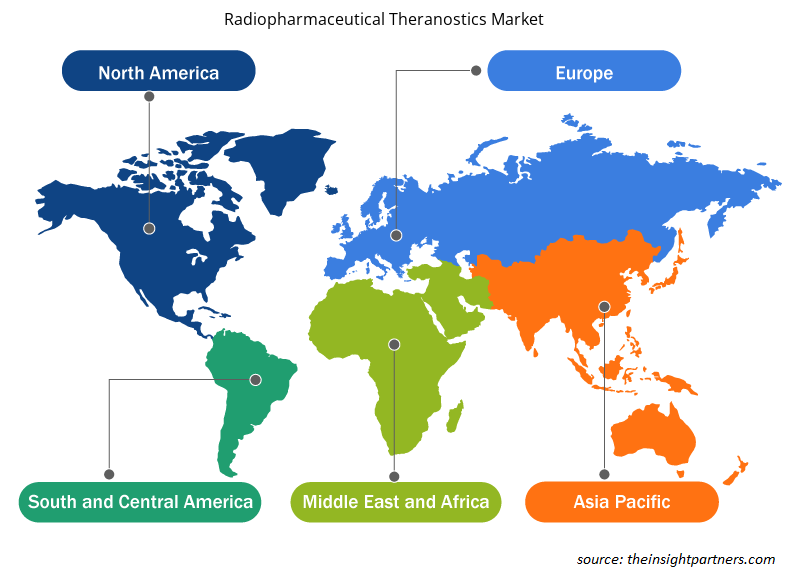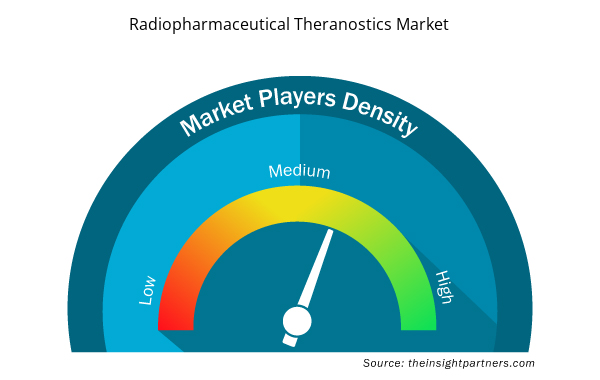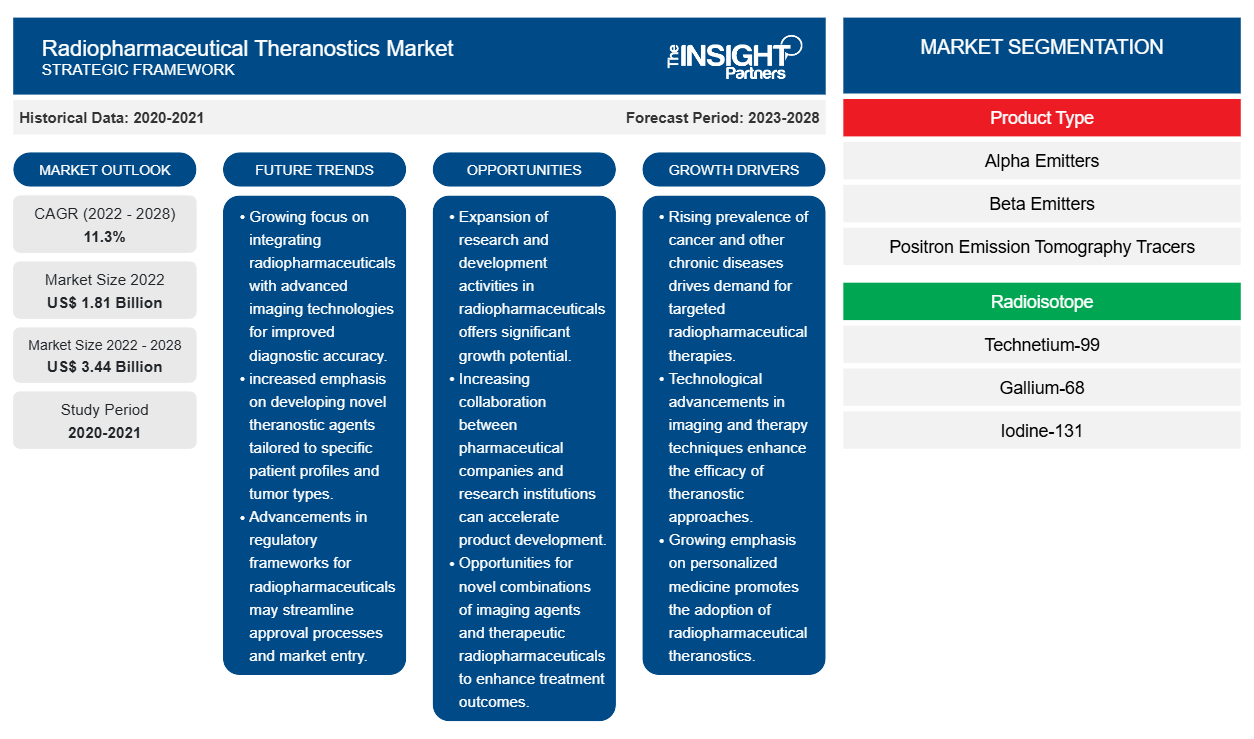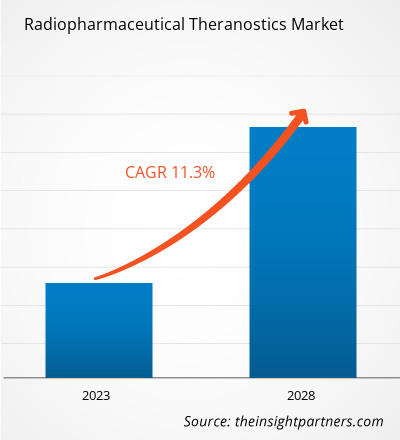[Forschungsbericht] Der Markt für radiopharmazeutische Theranostik soll von 1.814,58 Millionen US-Dollar im Jahr 2022 auf 3.441,97 Millionen US-Dollar im Jahr 2028 wachsen; von 2022 bis 2028 wird eine durchschnittliche jährliche Wachstumsrate (CAGR) von 11,3 % erwartet.
Der Markt für radiopharmazeutische Theranostik ist nach Produkttyp, Radioisotop, Quelle, Anwendung, Indikation, Endnutzer und Geografie segmentiert. Der Bericht bietet Einblicke und eine eingehende Analyse des Marktes und betont Parameter wie Dynamik, Trends und Chancen, die auf dem Markt für radiopharmazeutische Theranostik vorherrschen. Er bietet auch eine Wettbewerbslandschaftsanalyse der führenden Marktteilnehmer auf dem globalen Markt für radiopharmazeutische Theranostik.
Markteinblicke
Zunehmende Anwendung in der Behandlung von Herz-Kreislauf-Erkrankungen treibt das globale Wachstum des Marktes für radiopharmazeutische Theranostika voran
Herz-Kreislauf-Erkrankungen (CVDs) gehören zu den häufigsten chronischen Erkrankungen des 21. Jahrhunderts und weisen eine hohe Sterblichkeitsrate auf. Aufgrund der sitzenden Lebensweise sind CVDs die häufigste Todes- und Krankheitsursache in Industrieländern. Darüber hinaus werden Fettleibigkeit und Diabetes sowie verwandte Krankheiten mit Herz-Kreislauf-Erkrankungen in Verbindung gebracht und werden zu Komorbiditäten. Darüber hinaus ist eine Komplikation wie eine Koronararterienobstruktion eine der häufigsten Todesursachen bei Erwachsenen, die zu Thrombusablagerungen in der Intima der Arterienwand, hauptsächlich in der Halsschlagader, führt. Nach Angaben des National Center for Biotechnology starben 2015 weltweit rund 17,7 Millionen Menschen an Herz-Kreislauf-Erkrankungen. In diesem Zusammenhang wird geschätzt, dass die Sterblichkeit durch Herz-Kreislauf-Erkrankungen bis 2030 auf 22 Millionen steigen könnte. Therapeutische Anwendungen bei Herz-Kreislauf-Erkrankungen umfassen Nanomedizin bei Angina Pectoris, Myokarditis, Herzinfarkt, Perikarderkrankungen, Thrombose, Arteriosklerose, Hyperlipidämie, Bluthochdruck, pulmonaler arterieller Hypertonie und Schlaganfall. Theranostische Nanomedizin kann den systemischen Kreislauf verlängern, Abwehrsysteme des Wirts umgehen und Theranostik-Wirkstoffe zur Bildgebung und Therapie auf zellulärer und molekularer Ebene an die Zielstelle bringen.
Passen Sie diesen Bericht Ihren Anforderungen an
Sie erhalten kostenlos individuelle Anpassungen an jedem Bericht, einschließlich Teilen dieses Berichts oder einer Analyse auf Länderebene, eines Excel-Datenpakets sowie tolle Angebote und Rabatte für Start-ups und Universitäten.
- Holen Sie sich die wichtigsten Markttrends aus diesem Bericht.Dieses KOSTENLOSE Beispiel umfasst eine Datenanalyse von Markttrends bis hin zu Schätzungen und Prognosen.
Laut dem Bericht der Centers for Disease Control and Prevention (CDC) aus dem Jahr 2022 sind Herzerkrankungen eine der häufigsten Todesursachen bei Männern und Frauen in den USA. Im Jahr 2020 waren Herzerkrankungen in den USA für etwa 697.000 Todesfälle verantwortlich, also für jeden fünften Todesfall. Ein Bericht des National Institute of Health (NIH) besagt, dass Theranostik-Nanopartikel in der Medizin erhebliche Aufmerksamkeit erlangt haben, da die Techniken helfen, die mit Herz-Kreislauf-Erkrankungen verbundenen Komplexitäten und pathophysiologischen Komplikationen zu überwinden. Die kardiovaskuläre Bildgebung von Arteriosklerosepatienten liefert pathophysiologische Beweise, die bei der Behandlung von Herz-Kreislauf-Erkrankungen helfen können. Darüber hinaus können Theranostik-Nanopartikel mit einer Reihe von Bildgebungsverfahren kombiniert werden, wie etwa Magnetresonanztomographie (MRT) , Positronen-Emissions-Tomographie (PET) und Computertomographie (CT). Bisher wurden in klinischen Labors verschiedene klinische Forschungsstudien durchgeführt. Durch die Kombination einer polymeren photoakustischen Sonde mit Nanopartikeln-PLCDP@PMH wurde ein Drei-in-eins-Therapiekomplex entwickelt. Klinische In-vivo-Bewertungen zeigen, dass PLCDP@PMH lukrative Vorteile für den Theranostik-Ansatz zur Früherkennung von Arteriosklerose bei Patienten bietet.
Produkttypbasierte Einblicke
Basierend auf dem Produkttyp ist der Markt für radiopharmazeutische Theranostik in Positronen-Emissions-Tomographie (PET)-Tracer, Betastrahler und Alphastrahler segmentiert. Im Jahr 2022 hielt das Segment der Positronen-Emissions-Tomographie (PET)-Tracer den größten Marktanteil des globalen Marktes für radiopharmazeutische Theranostik und wird voraussichtlich im Prognosezeitraum die höchste CAGR verzeichnen.
Radioisotopenbasierte Erkenntnisse
Basierend auf Radioisotopen ist der Markt für radiopharmazeutische Theranostik in Lutetium (Lu) 177, Gallium-68, Iod-131, Iod-123, Technetium-99, Yttrium-90 (Y-90), Kupfer (Cu) 64, 18F, Kupfer (Cu) 67 und andere unterteilt. Im Jahr 2022 hielt das Segment Lutetium (Lu) 177 den größten Marktanteil am globalen Markt für radiopharmazeutische Theranostik und wird im Prognosezeitraum voraussichtlich die höchste CAGR verzeichnen.
Quellenbasierte Erkenntnisse
Der Markt für radiopharmazeutische Theranostik ist nach Quelle in Zyklotrone und Kernreaktoren unterteilt. Das Zyklotronsegment hatte im Jahr 2022 einen größeren Marktanteil und wird im Prognosezeitraum voraussichtlich eine höhere CAGR verzeichnen.
Anwendungsbasierte Erkenntnisse
Basierend auf der Anwendung ist der Markt für radiopharmazeutische Theranostik in zielgerichtete Therapie (Rx) und Begleitdiagnostik (CDx) unterteilt. Im Jahr 2022 hielt das Segment der zielgerichteten Therapie (Rx) einen größeren Marktanteil und es wird erwartet, dass es im Prognosezeitraum eine höhere CAGR verzeichnet.
Indikationsbasierte Erkenntnisse
Basierend auf der Indikation ist der Markt für radiopharmazeutische Theranostik in Onkologie, Neurologie, Kardiologie und andere segmentiert. Das Onkologiesegment hielt im Jahr 2022 den größten Marktanteil und wird voraussichtlich im Prognosezeitraum die höchste durchschnittliche jährliche Wachstumsrate verzeichnen.
Endbenutzerbasierte Erkenntnisse
Basierend auf dem Endverbraucher ist der Markt für radiopharmazeutische Theranostik in Krankenhäuser, Zentren für diagnostische Bildgebung, akademische und Forschungsinstitute und andere unterteilt. Das Segment Krankenhäuser hatte im Jahr 2022 den größten Marktanteil. Es wird jedoch erwartet, dass das Segment der akademischen und Forschungsinstitute im Prognosezeitraum die höchste CAGR verzeichnet. Krankenhäuser verwenden technologisch fortschrittliche Systeme zur Behandlung von Herzaneurysmen, neurologischen Aneurysmen, onkologischen Tumoren und anderen ähnlichen Erkrankungen. Die steigende Prävalenz verschiedener Krankheiten und eine zunehmende Anzahl von Krankenhäusern tragen zum Wachstum des Marktes für das Krankenhaussegment bei.
Die Akteure auf dem Markt für radiopharmazeutische Theranostik verfolgen organische Strategien wie Produkteinführung und -erweiterung, um ihre Präsenz und ihr Produktportfolio zu erweitern und der wachsenden Nachfrage gerecht zu werden. Anorganische Wachstumsstrategien, die auf dem Markt zu beobachten sind, sind Partnerschaften und Kooperationen. Diese Wachstumsstrategien haben es den Marktteilnehmern ermöglicht, ihre Geschäfte auszuweiten und ihre geografische Präsenz zu verbessern. Darüber hinaus helfen ihnen Akquisitionen, Partnerschaften und andere Wachstumsstrategien, ihren Kundenstamm zu stärken.
- Im Oktober 2022 erhielt Telix die Zulassung von Health Canada für sein Illuccix, ein Kit zur Herstellung einer Gallium-(68Ga)-Gozetotid-Injektion. Das Produkt kann zur Stadienbestimmung und Neustadienbestimmung von Prostatakrebs mit mittlerem und hohem Risiko sowie zur Lokalisierung von Tumorgewebe bei rezidivierendem Prostatakrebs verwendet werden. Illuccix war das erste PSMA-PET-Bildgebungsmittel, das in Kanada eine behördliche Zulassung erhielt. Health Canada war die dritte Regulierungsbehörde weltweit, die Illuccix zugelassen hat, das in Australien und den USA kommerziell erhältlich ist.
- Im Dezember 2021 gingen GE Healthcare und Minerva Imaging eine strategische Partnerschaft ein, um die Markteinführung gezielter Radionuklidtherapien (Theranostik) zu beschleunigen. Die Radionuklidtherapie ist eine Form der Präzisionsmedizin, bei der eine radioaktive Substanz über den Blutkreislauf verabreicht wird, um Krebszellen gezielt zu bestrahlen. Dies trägt dazu bei, potenzielle Nebenwirkungen im Vergleich zu herkömmlichen Krebstherapien zu reduzieren.
Regionale Einblicke in den Markt für radiopharmazeutische Theranostika
Die regionalen Trends und Faktoren, die den Markt für radiopharmazeutische Theranostika im Prognosezeitraum beeinflussen, wurden von den Analysten von Insight Partners ausführlich erläutert. In diesem Abschnitt werden auch die Marktsegmente und die Geografie für radiopharmazeutische Theranostika in Nordamerika, Europa, im asiatisch-pazifischen Raum, im Nahen Osten und Afrika sowie in Süd- und Mittelamerika erörtert.

- Erhalten Sie regionale Daten zum Markt für radiopharmazeutische Theranostik
Umfang des Marktberichts zur radiopharmazeutischen Theranostik
| Berichtsattribut | Details |
|---|---|
| Marktgröße im Jahr 2022 | 1,81 Milliarden US-Dollar |
| Marktgröße bis 2028 | 3,44 Milliarden US-Dollar |
| Globale CAGR (2022 - 2028) | 11,3 % |
| Historische Daten | 2020-2021 |
| Prognosezeitraum | 2023–2028 |
| Abgedeckte Segmente | Nach Produkttyp
|
| Abgedeckte Regionen und Länder | Nordamerika
|
| Marktführer und wichtige Unternehmensprofile |
|
Dichte der Marktteilnehmer für radiopharmazeutische Theranostika: Auswirkungen auf die Geschäftsdynamik verstehen
Der Markt für radiopharmazeutische Theranostika wächst rasant, angetrieben von der steigenden Nachfrage der Endnutzer aufgrund von Faktoren wie sich entwickelnden Verbraucherpräferenzen, technologischen Fortschritten und einem größeren Bewusstsein für die Vorteile des Produkts. Mit steigender Nachfrage erweitern Unternehmen ihr Angebot, entwickeln Innovationen, um die Bedürfnisse der Verbraucher zu erfüllen, und nutzen neue Trends, was das Marktwachstum weiter ankurbelt.
Die Marktteilnehmerdichte bezieht sich auf die Verteilung von Firmen oder Unternehmen, die in einem bestimmten Markt oder einer bestimmten Branche tätig sind. Sie gibt an, wie viele Wettbewerber (Marktteilnehmer) in einem bestimmten Marktraum im Verhältnis zu seiner Größe oder seinem gesamten Marktwert präsent sind.
Die wichtigsten auf dem Markt für radiopharmazeutische Theranostik tätigen Unternehmen sind:
- Bayer AG
- GE HealthCare Technologies Inc
- Curium
- Lantheus Medical Imaging, Inc.
- Telix Pharmaceuticals Ltd.
Haftungsausschluss : Die oben aufgeführten Unternehmen sind nicht in einer bestimmten Reihenfolge aufgeführt.

- Überblick über die wichtigsten Akteure auf dem Markt für radiopharmazeutische Theranostik
Firmenprofile - Markt für radiopharmazeutische Theranostik
- Bayer AG
- GE HealthCare Technologies Inc
- Curium
- Lantheus Medical Imaging, Inc.
- Telix Pharmaceuticals Ltd.
- Cardinal Health Inc
- Advanced Accelerator Applications SA
- Jubilant Radiopharma
- Theragnostik
- NuView Biowissenschaften
- Historische Analyse (2 Jahre), Basisjahr, Prognose (7 Jahre) mit CAGR
- PEST- und SWOT-Analyse
- Marktgröße Wert/Volumen – Global, Regional, Land
- Branche und Wettbewerbsumfeld
- Excel-Datensatz



Report Coverage
Revenue forecast, Company Analysis, Industry landscape, Growth factors, and Trends

Segment Covered
This text is related
to segments covered.

Regional Scope
North America, Europe, Asia Pacific, Middle East & Africa, South & Central America

Country Scope
This text is related
to country scope.
Häufig gestellte Fragen
Answer: - The targeted therapeutic [Rx] segment dominated the global radiopharmaceutical theranostics market and held the largest market share of 63.28% in 2022.
The oncology segment dominated the global radiopharmaceutical theranostics market and held the largest market share of 62.18% in 2022.
The hospitals segment dominated the global radiopharmaceutical theranostics market and held the largest market share of 36.28% in 2022.
The radiopharmaceutical theranostics market majorly consists of the players such Bayer AG, GE HealthCare Technologies Inc, Curium, Lantheus Medical Imaging, Inc.; Telix Pharmaceuticals Ltd.; Cardinal Health Inc, Advanced Accelerator Applications S.A.; Jubilant Radiopharma, Theragnostics, and NuView Life Sciences amongst others.
The cyclotrons segment dominated the global radiopharmaceutical theranostics market and held the largest market share of 60.42% in 2022.
The Lutetium (Lu) 177 segment dominated the global radiopharmaceutical theranostics market and held the largest market share of 24.34% in 2022.
The positron emission tomography (PET) tracers segment held the largest share of the market in the global radiopharmaceutical theranostics market and held the largest market share of 44.76% in 2022.
The CAGR value of the biopharmaceuticals market during the forecasted period of 2022-2028 is 11.3%.
Key factors that are driving the growth of this market are rising incidence of cancer and the growing application in the treatment of cardiovascular disorders are expected to boost the market growth for the radiopharmaceutical theranostics over the years.
Radiopharmaceuticals are radioisotopes that are bound to biological molecules that target specific tissues, organs, or cells within the human body. Radioisotopes emitting gamma rays are useful for diagnostic imaging where the radiation escapes the body. Nuclear medicine imaging generally utilizes radioactive isotopes attached to specific molecules to examine biological processes, such as disease pathophysiology. Every radiopharmaceutical is designed to travel to a specific location in the body, and as soon as it reaches the site, it releases radioactive substances that kill the tumor cells. Radiopharmaceuticals can target various malignancies such as prostate cancer, heart disease, thyroid cancer, and others. These drugs can also be used as both therapies and diagnostics, known as 'theranostics’. In theranostics, radiopharmaceuticals are used for therapeutic and diagnostic purposes by targeting one specific tumor receptor.
Trends and growth analysis reports related to Life Sciences : READ MORE..
The List of Companies - Radiopharmaceutical Theranostics Market
- Bayer AG
- GE HealthCare Technologies Inc
- Curium
- Lantheus Medical Imaging, Inc.
- Telix Pharmaceuticals Ltd.
- Cardinal Health Inc
- Advanced Accelerator Applications S.A.
- Jubilant Radiopharma
- Theragnostics
- NuView Life Sciences
The Insight Partners performs research in 4 major stages: Data Collection & Secondary Research, Primary Research, Data Analysis and Data Triangulation & Final Review.
- Data Collection and Secondary Research:
As a market research and consulting firm operating from a decade, we have published and advised several client across the globe. First step for any study will start with an assessment of currently available data and insights from existing reports. Further, historical and current market information is collected from Investor Presentations, Annual Reports, SEC Filings, etc., and other information related to company’s performance and market positioning are gathered from Paid Databases (Factiva, Hoovers, and Reuters) and various other publications available in public domain.
Several associations trade associates, technical forums, institutes, societies and organization are accessed to gain technical as well as market related insights through their publications such as research papers, blogs and press releases related to the studies are referred to get cues about the market. Further, white papers, journals, magazines, and other news articles published in last 3 years are scrutinized and analyzed to understand the current market trends.
- Primary Research:
The primarily interview analysis comprise of data obtained from industry participants interview and answers to survey questions gathered by in-house primary team.
For primary research, interviews are conducted with industry experts/CEOs/Marketing Managers/VPs/Subject Matter Experts from both demand and supply side to get a 360-degree view of the market. The primary team conducts several interviews based on the complexity of the markets to understand the various market trends and dynamics which makes research more credible and precise.
A typical research interview fulfils the following functions:
- Provides first-hand information on the market size, market trends, growth trends, competitive landscape, and outlook
- Validates and strengthens in-house secondary research findings
- Develops the analysis team’s expertise and market understanding
Primary research involves email interactions and telephone interviews for each market, category, segment, and sub-segment across geographies. The participants who typically take part in such a process include, but are not limited to:
- Industry participants: VPs, business development managers, market intelligence managers and national sales managers
- Outside experts: Valuation experts, research analysts and key opinion leaders specializing in the electronics and semiconductor industry.
Below is the breakup of our primary respondents by company, designation, and region:

Once we receive the confirmation from primary research sources or primary respondents, we finalize the base year market estimation and forecast the data as per the macroeconomic and microeconomic factors assessed during data collection.
- Data Analysis:
Once data is validated through both secondary as well as primary respondents, we finalize the market estimations by hypothesis formulation and factor analysis at regional and country level.
- Macro-Economic Factor Analysis:
We analyse macroeconomic indicators such the gross domestic product (GDP), increase in the demand for goods and services across industries, technological advancement, regional economic growth, governmental policies, the influence of COVID-19, PEST analysis, and other aspects. This analysis aids in setting benchmarks for various nations/regions and approximating market splits. Additionally, the general trend of the aforementioned components aid in determining the market's development possibilities.
- Country Level Data:
Various factors that are especially aligned to the country are taken into account to determine the market size for a certain area and country, including the presence of vendors, such as headquarters and offices, the country's GDP, demand patterns, and industry growth. To comprehend the market dynamics for the nation, a number of growth variables, inhibitors, application areas, and current market trends are researched. The aforementioned elements aid in determining the country's overall market's growth potential.
- Company Profile:
The “Table of Contents” is formulated by listing and analyzing more than 25 - 30 companies operating in the market ecosystem across geographies. However, we profile only 10 companies as a standard practice in our syndicate reports. These 10 companies comprise leading, emerging, and regional players. Nonetheless, our analysis is not restricted to the 10 listed companies, we also analyze other companies present in the market to develop a holistic view and understand the prevailing trends. The “Company Profiles” section in the report covers key facts, business description, products & services, financial information, SWOT analysis, and key developments. The financial information presented is extracted from the annual reports and official documents of the publicly listed companies. Upon collecting the information for the sections of respective companies, we verify them via various primary sources and then compile the data in respective company profiles. The company level information helps us in deriving the base number as well as in forecasting the market size.
- Developing Base Number:
Aggregation of sales statistics (2020-2022) and macro-economic factor, and other secondary and primary research insights are utilized to arrive at base number and related market shares for 2022. The data gaps are identified in this step and relevant market data is analyzed, collected from paid primary interviews or databases. On finalizing the base year market size, forecasts are developed on the basis of macro-economic, industry and market growth factors and company level analysis.
- Data Triangulation and Final Review:
The market findings and base year market size calculations are validated from supply as well as demand side. Demand side validations are based on macro-economic factor analysis and benchmarks for respective regions and countries. In case of supply side validations, revenues of major companies are estimated (in case not available) based on industry benchmark, approximate number of employees, product portfolio, and primary interviews revenues are gathered. Further revenue from target product/service segment is assessed to avoid overshooting of market statistics. In case of heavy deviations between supply and demand side values, all thes steps are repeated to achieve synchronization.
We follow an iterative model, wherein we share our research findings with Subject Matter Experts (SME’s) and Key Opinion Leaders (KOLs) until consensus view of the market is not formulated – this model negates any drastic deviation in the opinions of experts. Only validated and universally acceptable research findings are quoted in our reports.
We have important check points that we use to validate our research findings – which we call – data triangulation, where we validate the information, we generate from secondary sources with primary interviews and then we re-validate with our internal data bases and Subject matter experts. This comprehensive model enables us to deliver high quality, reliable data in shortest possible time.


 Holen Sie sich ein kostenloses Muster für diesen Bericht
Holen Sie sich ein kostenloses Muster für diesen Bericht